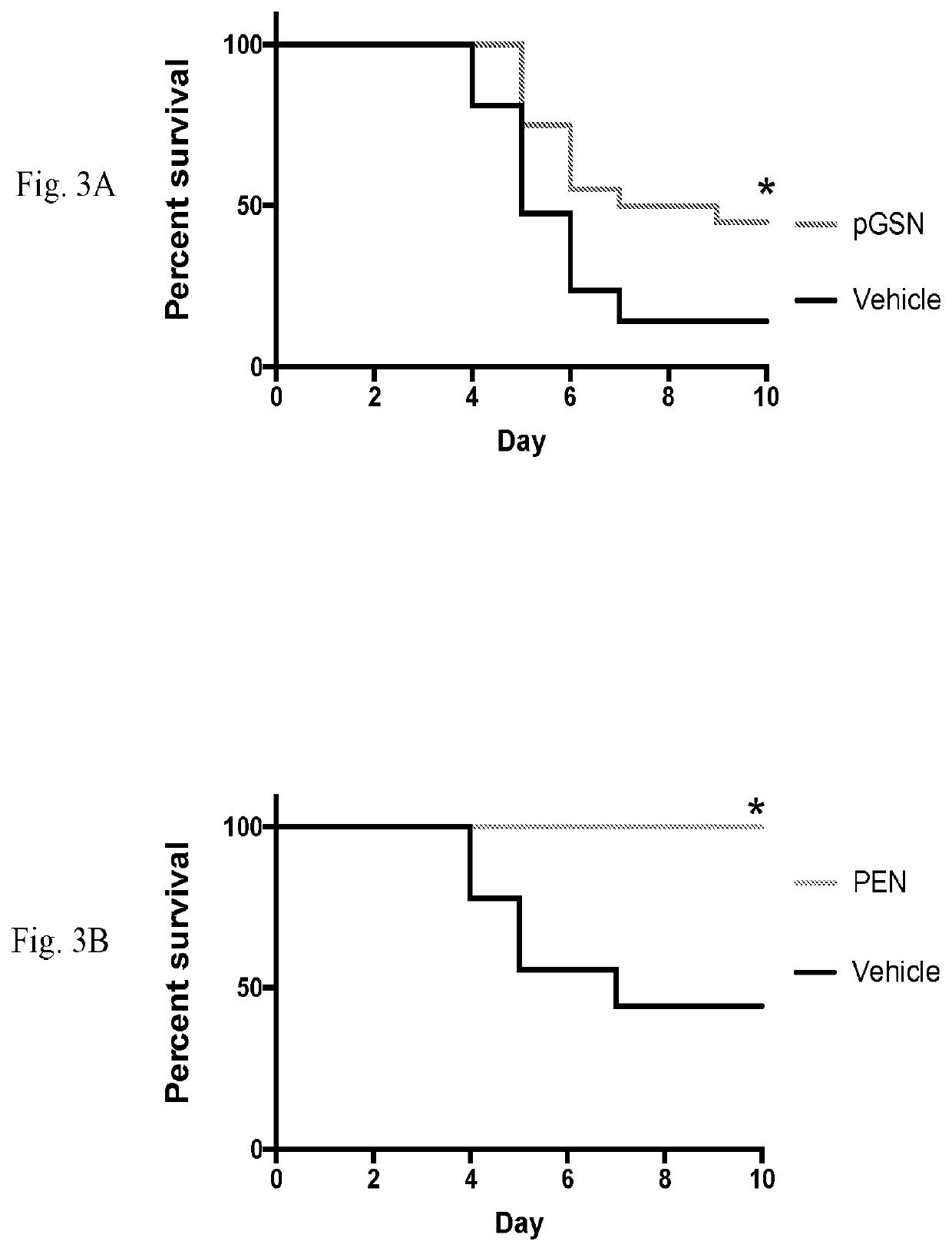Compositions and synergistic methods for treating infections
a technology applied in the field of compositions and synergistic methods for treating infections, can solve the problems of increasing the types of pathogenic infections that are less responsive, the risk of microbial infection is reduced, and the therapeutic efficacy of a variety of antimicrobial agents is known to be reduced, so as to reduce the risk of microbial infection, slow or perhaps prevent the development of an infection. the effect of the infection and the reduction of the risk of infection
- Summary
- Abstract
- Description
- Claims
- Application Information
AI Technical Summary
Benefits of technology
Problems solved by technology
Method used
Image
Examples
example 1
[0127]Antibiotic resistant pneumococcal pneumonia occur and can be problematic. Studies have been conducted to assess a novel therapeutic strategy for combating infections that includes means to augment innate immunity. Experiments were performed to determine the effect of pGSN administration on macrophages and host survival.
Methods
Bacterial Strains and Culture
[0128]S. pneumoniae serotype 3 (catalog no. 6303, American Type Culture Collection, Rockville, Md.) were cultured overnight on 5% sheep blood-supplemented agar petri dishes (catalog no. 90001-282, VWR, West Chester, Pa.) and prepared and quantified as previously reported (Yang Z. et al., Am J Physiol Lung Cell Mol Physiol 2015; 309:L11-6).
In Vitro and In Vivo Procedures
(1) In Vitro Studies
[0129]In vitro studies were performed in which 125-250 μg / ml pGSN was added to bacterial cultures and bacterial survival was determined.
(2) In Vivo Studies
[0130]Bl6 mice were challenged with 105 pneumococci by i.n. insufflation and were admin...
example 2
[0134]Studies were performed to evaluate effects of pGSN treatment on antibiotic-sensitive and antibiotic-resistant mouse models of pneumococcal pneumonia.
Methods
Bacterial Strains and Culture
[0135]S. pneumoniae serotypes 3 and 14 (Catalog nos. 6303 and 700677, respectively) were obtained from the American Type Culture Collection (Rockville, Md.). Serotype 3 bacteria were cultured overnight on 5% sheep blood-supplemented agar petri dishes (Catalog no. 90001-282, VWR, West Chester, Pa.) and prepared and quantified as previously reported (Yang Z. et al., Am J Physiol Lung Cell Mol Physiol 2015; 309:L11-6). Because serotype 14 required a more detailed protocol to achieve consistent results, the growth protocol reported in Restrepo A V et al., BMC Microbiol 2005; 5:34 was followed, which uses two sequential expansions in liquid broth culture before centrifugation and adjustment of bacterial concentration by OD600 for in vivo administration.
Mouse Models of Pneumococcal Pneumonia
[0136]Norm...
example 3
[0146]Studies were performed to evaluate effects of rhu-pGSN treatment to meropenem in highly lethal, multidrug-resistant P. aeruginosa pneumonia in a neutropenic mouse model.
Methods
[0147]Production of rhu-pGSN
[0148]Recombinant human plasma gelsolin (rhu-pGSN), was produced in E. coli and subsequently lyophilized for reconstitution. Vehicle controls containing formulation components were used for the comparator mice.
Bacteria Strain and Growth Conditions
[0149]P. aeruginosa UNC-D is a sputum isolate from a patient with cystic fibrosis. [Lawrenz M B, et al. Pathog. Dis. 73 (2015)]. Bacteria were cultured on trypticase soy agar (TSA) plates and in Lennox broth at 37° C. with shaking of broth cultures. Minimum inhibitory concentrations of the UNC-D strain are: ceftazidime [32 μg / ml], meropenem [8 μg / ml], imipenem [16 μg / ml], tobramycin [32 μg / ml], piperacillin [16 μg / ml], aztreonam [4 μg / ml], colistin [1 μg / ml], and fosfomycin [256 μg / mL]. Bacteria were prepared for animal challenge stud...
PUM
| Property | Measurement | Unit |
|---|---|---|
| concentrations | aaaaa | aaaaa |
| Δ | aaaaa | aaaaa |
| body temperature | aaaaa | aaaaa |
Abstract
Description
Claims
Application Information
 Login to View More
Login to View More - R&D
- Intellectual Property
- Life Sciences
- Materials
- Tech Scout
- Unparalleled Data Quality
- Higher Quality Content
- 60% Fewer Hallucinations
Browse by: Latest US Patents, China's latest patents, Technical Efficacy Thesaurus, Application Domain, Technology Topic, Popular Technical Reports.
© 2025 PatSnap. All rights reserved.Legal|Privacy policy|Modern Slavery Act Transparency Statement|Sitemap|About US| Contact US: help@patsnap.com



